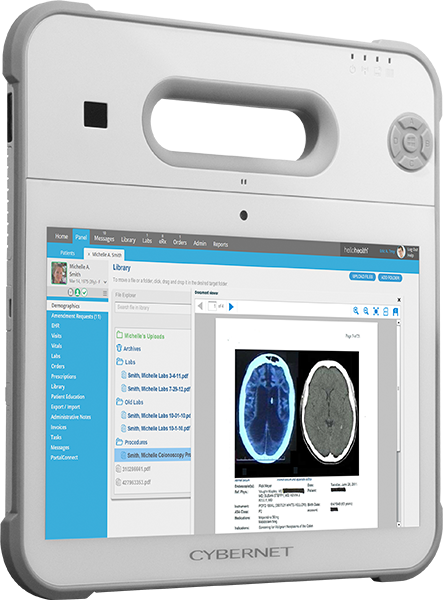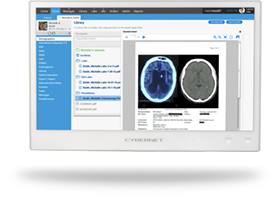A casualty of the digital transformation of healthcare is paper. Expensive office spaces, which once housed boxes of bulky paper patient records, have been repurposed into more useful roles such as waiting areas, providers' offices, and examination rooms. Patient medical histories, provider SOAP notes, and other vital information are now housed onsite in healthcare IT departments, offsite in the cloud, or in both locations.
- What Does Going Paperless in Healthcare Mean?
- Benefits of Going Paperless in Healthcare
- Roadblocks to Going Paperless in Healthcare
- Best Practices for a Smooth Transition
What Does Going Paperless in Healthcare Mean?
Simply, "going paperless" means replacing paper-based documentation systems that were once used throughout healthcare with digital alternatives, typically viewed through medical computers. Common examples include:
- Electronic Health Records (EHRs) contain a patient's health information, including every exam, medications, and other relevant details.
- Digital imaging and diagnostics storage of everything from X-rays to MRI scans to EKG readings.
- E-Prescriptions sent by the provider to the patient's pharmacies.
- Cloud-based patient management systems, which office staff use to manage appointments, billings, and communications.
- Digital billing and insurance claims are processed on medical coding and billing computers, enabling the healthcare group to receive prompt payment for services rendered.
Benefits of Going Paperless in Healthcare
The first modern medical records can be traced back to the late 18th and early 19th centuries. They were written on paper, of course, a practice that would continue until the early 2000s, when computers and electronic health records became more prevalent. The benefits of transitioning from paper to digital quickly made themselves felt.
Improved Patient Care
Providers have real-time access to a patient's information using EHR, from medical history to test results to medications. They don't have to wait for patient records to be retrieved from the file room or another part of the hospital (or even outside of it, such as in cases of out-of-state records). EHRs reduced errors in patient health information, improved collaboration among involved healthcare professionals, and helped in speeding up diagnosis and decision-making.
Enhanced Efficiency and Productivity
Paperwork-intensive routine tasks, like appointment scheduling, test result delivery, and insurance processing, could now be handled by patient management systems and even medical AI computers. Automation of administrative workflows freed staff to provide higher-quality patient care without the additional expense of overtime or extra staffing.
Cost Savings
Paper records cost the healthcare sector between $18 billion and $22 billion annually. These figures not only include the costs for reams of paper used, printing, and ink, but also storage space, time spent looking for the documents, and correcting errors made by hapless workers. Paperless options reduce these expenses, sometimes drastically, as records are stored in much smaller onsite servers or offsite in healthcare-dedicated cloud services.
Better Compliance and Security
Paper records rely on physical barriers, like a locked file cabinet or room, to protect them from unauthorized access. And if one (or more!) are stolen, it could be some time before the theft is discovered, especially if there are hundreds to even thousands of files cluttering the storage space.
Healthcare single sign-on, encryption, and other sophisticated access control methods ensure that electronic healthcare records remain secure and private, in compliance with regulations such as the Health Insurance Portability and Accountability Act (HIPAA).
Environmental Sustainability
Finally, going paperless can aid meeting sustainability goals in the healthcare group, like reducing one's carbon footprint. Paper's carbon footprint is massive, encompassing everything from the sourcing of trees, pulping them into paper products, transportation, and finally, the recycling process. Running digital records can drastically cut a medical group's footprint, especially if running them via green computing solutions.
Roadblocks to Going Paperless in Healthcare
One would think that the numerous benefits of going paperless would prompt healthcare groups to scramble to implement electronic medical records and similar technologies. Groups that have done so have discovered that the road has many bumps, slowing the adoption process.
High Upfront Costs
Digital technologies, from their software to hardware such as medical tablets, require substantial investment. This also includes updates to the medical group's internal networks, the purchase of cloud space, and training staff in the use of various technologies.
Staff Resistance
Providers, medical staff, and office personnel may be resistant to learning or using the various devices, as they are already comfortable with paper-based processes and workflows.
Data Security Concerns
Patient data is highly valuable to the criminal element, making data security critical in healthcare. Healthcare IT will need to step up to ensure all digital files are properly secured and protected. This may include training staff in access control technologies, such as RFID or advanced means like biometric authentication.
System Downtime and Integration Issues
Record retrieval, prescription issuance and refills, and other standard workflows may slow down or be interrupted as the group switches to paperless solutions. This roadblock includes everything from educating staff on the new technologies to integrating old and new devices through legacy ports.
Best Practices When Transitioning To Paperless in Healthcare
Healthcare groups may struggle to balance the numerous benefits of paperless systems against the advantages of maintaining current paper-based systems. The following suggestions can help you make that decision.
- Start Small and Scale – Don't switch the entire organization to the new system(s) at once. Instead, plan with one department, such as medical coding and billing.
- Choose the Right Technology – Select digital systems that are user-friendly, compliant, and, most importantly, scalable. An original equipment manufacturer (OEM) can be a valuable asset, as it is familiar with the ins and outs of its products.
- Prioritize Data Security – It cannot be overstated that the importance of keeping patient health information secure is paramount, as penalties range from substantial fines to jail time. Invest in the best cybersecurity that your healthcare budget can afford.
- Train Staff Thoroughly – All relevant users should receive initial training and follow-up sessions until they feel comfortable with the new digital tools. If budget allows, consider having a trainer on standby to answer questions and troubleshoot.
- Engage Patients – Paperless devices to be used by patients should be introduced to them slowly and in small groups (see above on starting small). Technologies included patient kiosks and digital front doors.
Run Paperless Solutions Effectively Thanks to Cybernet Computers
Medical groups all use paper, from patient records to prescriptions. By going paperless in healthcare, they reap numerous benefits, such as easy collaboration among providers, while eliminating costly expenses like storage space for paper files.
Is your healthcare organization looking to transition to a paperless system across its facilities? Contact Cybernet Manufacturing for more info. We'll be happy to review how our medical computer lineup can aid in your efforts. The lineup, which includes all-in-one medical PCs, medical-grade monitors, and more, has been designed from the inside out to address the sector's challenges, such as 24/7 operations. And if you can't find what you're looking for, no problem! As an OEM, we have full control over our design and manufacturing processes, allowing us to tailor them to meet your exact needs and requirements.

